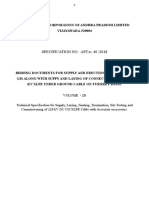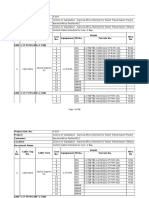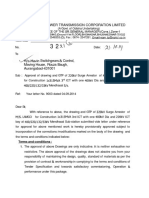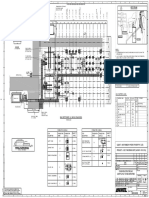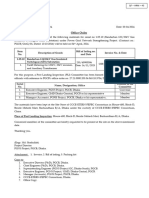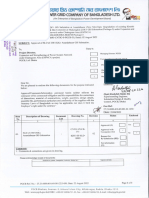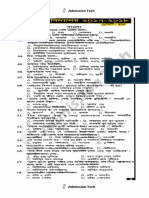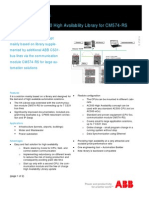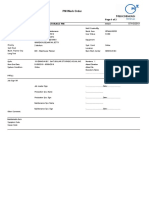DSLP
Uploaded by
jack paglaDSLP
Uploaded by
jack paglaProject Name: Design, Supply, Installation, Testing & Commissioning of 230/132kV &
132/33kV Substation on Turnkey Basis (Package-1.1)
Contract No.: PGCB/KfW/BMZ.2014.67.976/2018/Package-1-1
PROTECTION ZONE
CALCULATION FOR LIGHTING
Name Date Signature
Designed by 魏穗涵 (W.S) 21-12-2022
Checked by 魏涵穗 (R.S) 11-01-2023
INDEX OF REVISIONS:
REV DATE REVISED NAME PAGES REMARK
00 03-03-2022 -- 8 FOR APPROVAL
01 29-01-2023 -- 9 FOR APPROVAL
Standard: IEEE 998-2012
Design Method: Rolling Sphere
Energy Efficiency in Grid-based Power Supply Project
Package 1.1 1 of 9
1. Introduction:
Lightning stroke can cause fatality structural damage, and could lead to malfunction of the
electric equipment. The lightning stroke will vary by characteristics from area to area. The
lightning itself is an emission or discharge of electricity from cloud to ground, from ground to
cloud and from cloud to cloud. When the lightning strikes the ground, it chooses a path with
low resistance. According to the IEEE standard 998-1996 “the stroke occurs in two steps, the
first is ionization of the air surrounding the centre and the development of stepped leaders,
which propagate charge from the cloud into the air”. The second step is return stroke,
according to the same standard, “the return stroke is the extremely bright streamer that
propagates upward from the earth to the cloud following the same path as the main channel
of the downward stepped leader”.
Direct stroke lightning protection for Bhulta 230/132kV Sub-station is provided by shield wire.
Each lightning conductor consists shield wire, the earthing grid and the conductor which
connects the shield wire with the earthing grid meant to carry the lightning current away safely
to the ground.
2. Description of DSLP Calculation:
The submitted calculation is done by the “Rolling Sphere Method” as per the description of
IEEE standard 998-1996.
Basics for the calculation:
❖ Rolling sphere method:
The technique involves rolling an imaginary sphere of prescribed radius over the surface of a
substation. The sphere rolls up and over lightning shield and other grounded metal objects
intended for lightning protection. A piece of equipment is protected from a direct stroke if it
remains below the curved surface of the sphere by virtue of the sphere being elevated by
shield wires or other devices. Equipment that touches the sphere or penetrates its surface is
not protected.
❖ Shield wire (Overhead ground wire/Sky wire):
A wire suspended above the phase conductors positioned with the intention of having lightning
strike it instead of the phase conductors.
❖ Striking Distance:
The length of the final jump of the stepped leader as its potential exceeds the breakdown
resistance of this last gap; found to be related to the amplitude of the first return stroke.
❖ Surge Impedance:
The ratio of voltage and current of a wave that travels on a conductor.
3. Reference documents:
IEEE std 998-1996: IEEE Guide for Direct Lightning Stroke Shielding of Substations.
4. Calculation:
Area wise calculations have been shown one by one.
Energy Efficiency in Grid-based Power Supply Project
Package 1.1 2 of 9
CALCULATION FOR 230KV SIDE (SINGLE SHIELD WIRE)
1. Striking distance(S) calculation
Substation Data
1 Rated voltage = 230 kV
2 Average height of the conductor, h = 7.9 m
3 Rated lighting impulse withstand V0 = 1050 kV
voltage,
4 Limiting corona gradient, E0 = 1500 kV/m
5 Radius of conductor, r = 0.0192 m
6 No of conductor in a = 1 nos
bundle,
7 Spacing between adjacent conductors l = 0 m
8 The basic impulse level in kilovolts, BIL = 1050 kV
The corona radius (Rc)
The corona radius is given by the following equation,
Rc x ln {(2xh)/ Rc } – (Vc / E0) = 0 ... (equation C.1: IEEE Std 998-
2012.)
After solving equation, Rc = 0.149 m
Surge impedance (Zs):
The surge impedance of conductors under corona is given as,
Zs = 60 x √(ln(2 x h/Rc) x ln (2xh/r)) ... (equation C.5: IEEE Std 998-
2012.)
= 335.7188 ohm
Stroke current (Is):
The allowable stroke current is obtained by
Is = 2.2BIL/ Zs ... (equation 18: IEEE Std 998-
2012.)
= 6.881 kA
Striking distance (S)
The striking distance is related to the magnitude of the stroke current and it is obtained by
S = 8kIs0.65
= 28.04 m ... (equation 17: IEEE Std 998-
2012.)
Energy Efficiency in Grid-based Power Supply Project
Package 1.1 3 of 9
2. Maximum horizontal separation (C) of shield wire and equipment for protection at
height 7.9m
Here,
Height of shield wire, H = 22 m
Height of equipment or Bus conductor, A = 7.9 m
Striking distance (S) = 28.04 m
𝑅 = √(𝑆 2 + (𝑆 − 𝐻)2 )
= 27.37 m
T = √(𝑆 2 + (𝑆 − 𝐴)2 )
= 19.50 m
C = 𝑅 −𝑇
= 7.87 m
Conclusion:
The maximum height of equipment under a single shield wire in 230kV Side is a 230kV Bushing of
the transformer which is 7.9m. The maximum horizontal distance of bushing from the single shield
wire is 3.4m which is less than protected distance 7.87m.
Here, protective angle = tan -1 (H/ S) = tan -1 (22/ 28.04) = 37.950
According to Horvath’s Suggestion protection angle is less 400 is achieved for single shield wire.
All equipment under single shield wire is achieved.
Energy Efficiency in Grid-based Power Supply Project
Package 1.1 4 of 9
1. Checking of maximum protected height (A) between two shield wires:
Here,
Height of shield wire, H = 22 m
Striking distance = 28.03 m
(S)
Distance between two parallel shield Wire (SW), = 16
X
L = 𝑋/2
= 8 m
E = √(𝑆 2 − 𝐿2 )
= 26.86 m
𝐷 = 𝑆 −𝐸
1.17 m
𝐴 = 𝐻 −𝐷
= 20.83 m
Conclusion:
Under zone 3 the maximum height conductor is 7.9m (230kV transformer bushing) which is less
than protection Zone height (A) 20.83m. So, all equipment height within 7.9m under zone 3 is
protected.
Energy Efficiency in Grid-based Power Supply Project
Package 1.1 5 of 9
CALCULATION FOR 132KV SIDE (SINGLE SHIELD WIRE)
1. Striking distance(S) calculation
Substation Data
1 Rated voltage = 132 kV
2 Average height of the conductor, h = 4.5 m
Rated lighting impulse withstand
3 voltage, V0 = 650 kV
4 Limiting corona gradient, E0 = 1500 kV/m
5 Radius of conductor, r = 0.0192 m
6 No of conductor in a bundle, = 1 nos
7 Spacing between adjacent conductors l = 0 m
8 The basic impulse level in kilovolts, BIL = 650 kV
9 strikes on shield wire K = 1
The corona radius (Rc)
The corona radius is given by the following equation,
Rc x ln {(2xh)/ Rc } – (V0 / E0) = 0 ... (equation C.1: IEEE Std 998-2012.)
After solving equation, Rc = 0.0953 m
Surge impedance(Zs):
The surge impedance of conductors under corona is given as,
60 x √(ln(2 x h/Rc) x ln
Zs = (2xh/r)) ... (equation C.5: IEEE Std 998-2012.)
= 317.33 ohm
Stroke current (Is):
The allowable stroke current is obtained by
Is = 2.2BIL/ Zs ... (equation 18: IEEE Std 998-2012.)
= 4.506 kA
Striking distance (S)
The striking distance is related to the magnitude of the stroke current and it is obtained by
S = 8kIs0.65
= 21.29 m ... (equation 17: IEEE Std 998-2012.)
Energy Efficiency in Grid-based Power Supply Project
Package 1.1 6 of 9
2. Maximum horizontal separation (C) of shield wire and equipment for protection at
height 4.5 m
Here,
Height of shield wire, H = 16.2 m
Height of equipment or Bus conductor, A = 4.5 m
Striking distance (S) = 21.29 m
𝑅 = √(𝑆 2 + (𝑆 − 𝐻)2 )
= 20.67 m
T = √(𝑆 2 + (𝑆 − 𝐴)2 )
= 13.09 m
C = 𝑅 −𝑇
= 7.58 m
Conclusion:
The maximum height of equipment under a single shield wire in 132kV Side is a CSE which is
4.5m. The horizontal distance of CSE from the shield wire is 5m which is less than protected
distance 7.58m.
Here, protective angle = tan -1 (H/ S) = tan -1 (16.2/ 21.29) = 37.230
According to Horvath’s Suggestion protection angle is less 400 is achieved for single shield wire.
All equipment under single shield wire is achieved.
Energy Efficiency in Grid-based Power Supply Project
Package 1.1 7 of 9
CALCULATION FOR 132KV SIDE (DOUBLE SHIELD WIRE)
1. Striking distance(S) calculation
Substation Data
1 Rated voltage = 132 kV
2 Average height of the conductor, h = 12.7 m
3 Rated lighting impulse withstand V0 = 650 kV
voltage,
4 Limiting corona gradient, E0 = 1500 kV/m
5 Radius of conductor, r = 0.0192 m
6 No of conductor in a = 1 nos
bundle,
7 Spacing between adjacent conductors l = 0 m
8 The basic impulse level in kilovolts, BIL = 650 kV
The corona radius (Rc)
The corona radius is given by the following equation,
Rc x ln {(2xh)/ Rc } – (V0 / E0) = 0 ... (equation C.1: IEEE Std 998-
2012.)
After solving equation , Rc = 0.074 m
Surge impedance(Zs):
The surge impedance of conductors under corona is given as,
Zs = 60 x √(ln(2 x h/Rc) x ln (2xh/r)) ... (equation C.5: IEEE Std 998-
2012.)
= 388.679 ohm
Stroke current (Is):
The allowable stroke current is obtained by
Is = 2.2BIL/ Zs ... (equation 18: IEEE Std 998-
2012.)
= 3.679 kA
Striking distance (S)
The striking distance is related to the magnitude of the stroke current and it is obtained by
S = 8kIs0.65
= 18.66 m ... (equation 17: IEEE Std 998-
2012.)
Energy Efficiency in Grid-based Power Supply Project
Package 1.1 8 of 9
2. Checking of maximum protected height (A) between two shield wires:
Here,
Height of shield wire, H = 16.2 m
Striking distance (S) = 18.68 m
Distance between two parallel shield Wire (SW), X = 12
L = 𝑋/2
= 6 m
E = √(𝑆 2 − 𝐿2 )
= 17.67 m
𝐷 = 𝑆 −𝐸
0.99 m
𝐴 = 𝐻 −𝐷
= 15.21 m
Conclusion:
According to the layout, maximum height of conductor in the 132kV Side under 2 parallel shield
wire is 12.7m. So, all the equipment under zone 2 is protected.
Energy Efficiency in Grid-based Power Supply Project
Package 1.1 9 of 9
You might also like
- D.S.L.P Calculation For 100Kv Switchyard For Centur Rayon by Rolling Sphere Method, As Per IEEE-std 998-199650% (2)D.S.L.P Calculation For 100Kv Switchyard For Centur Rayon by Rolling Sphere Method, As Per IEEE-std 998-199636 pages
- 1 Normal Tower 2 +3M Extn. Only 3 +6M Extn Only 4 StubNo ratings yet1 Normal Tower 2 +3M Extn. Only 3 +6M Extn Only 4 Stub11 pages
- The Notion of Freedom in Krishnamurti and SartreNo ratings yetThe Notion of Freedom in Krishnamurti and Sartre10 pages
- Vol-2B Tech Spec.220kV XLPE Cable MedhaNo ratings yetVol-2B Tech Spec.220kV XLPE Cable Medha43 pages
- 132kv-220kv Long Rod SRC insulator-APTRANSCONo ratings yet132kv-220kv Long Rod SRC insulator-APTRANSCO7 pages
- Electical Calculation EN2021-1132 (220kV)No ratings yetElectical Calculation EN2021-1132 (220kV)3 pages
- Calculation of CT Parameter Parameter Remark Description (I) Generator Parameter100% (1)Calculation of CT Parameter Parameter Remark Description (I) Generator Parameter20 pages
- R0_400kV CCS FOR ICT-4 (BAY-415)_R0 (1)No ratings yetR0_400kV CCS FOR ICT-4 (BAY-415)_R0 (1)11 pages
- 1-Calculate Overhead Line Conductor Resistance Per Unitlength by ASTM Standard100% (1)1-Calculate Overhead Line Conductor Resistance Per Unitlength by ASTM Standard9 pages
- R2-Earthmat - Calculations-MIOA-0.5Sec (00000002)No ratings yetR2-Earthmat - Calculations-MIOA-0.5Sec (00000002)13 pages
- 380KV Gis Expansion of Al Dhahiyah BSP - CT & PT Sizing CalculationNo ratings yet380KV Gis Expansion of Al Dhahiyah BSP - CT & PT Sizing Calculation24 pages
- Substation Model 765 KV Public Comments 11th Jan-09No ratings yetSubstation Model 765 KV Public Comments 11th Jan-0922 pages
- Gantry Structure Calculation - T Type Rev - 1No ratings yetGantry Structure Calculation - T Type Rev - 12 pages
- ILLUMINATION LAYOUT OF INVERTER STATION (TYPICAL) - 8VSG592702-19009 - Rev A - CAT I - 12.12.2020No ratings yetILLUMINATION LAYOUT OF INVERTER STATION (TYPICAL) - 8VSG592702-19009 - Rev A - CAT I - 12.12.20203 pages
- Khafji 5 SS - CT Sizing Calculation Rev-ANo ratings yetKhafji 5 SS - CT Sizing Calculation Rev-A138 pages
- SS-0150-TJR-DWG-ELE-004 - Auxiliary Single Line Diagram (Along With UPS) - PV1-IS01No ratings yetSS-0150-TJR-DWG-ELE-004 - Auxiliary Single Line Diagram (Along With UPS) - PV1-IS011 page
- 220kV Lines at Rajokheri Technical Specifications PDFNo ratings yet220kV Lines at Rajokheri Technical Specifications PDF421 pages
- Pgcil - Spacers For Bersimis - 400kv & 220kv - Type Test ReportNo ratings yetPgcil - Spacers For Bersimis - 400kv & 220kv - Type Test Report7 pages
- Modelling of 132 KV Overhead Transmission Lines byNo ratings yetModelling of 132 KV Overhead Transmission Lines by11 pages
- SM-SY-03-0024 Rev 1 - Foundation, Structure and Gantry Layout of 66kV SwitchyardNo ratings yetSM-SY-03-0024 Rev 1 - Foundation, Structure and Gantry Layout of 66kV Switchyard13 pages
- KEC International Limited: Power T & D Cables Railways Civil Solar100% (1)KEC International Limited: Power T & D Cables Railways Civil Solar42 pages
- Title: Document/Drawing Approval/Comment Transmittal: Kind AttnNo ratings yetTitle: Document/Drawing Approval/Comment Transmittal: Kind Attn2 pages
- Estudio de Coordinacion de Insulacion de 500kV y 230kVNo ratings yetEstudio de Coordinacion de Insulacion de 500kV y 230kV77 pages
- PLI Office Order For Bandarban, Ship-045No ratings yetPLI Office Order For Bandarban, Ship-0451 page
- (AC) Cable Trench Civil Drawing For Birulia SS Under KFW Package 1.1No ratings yet(AC) Cable Trench Civil Drawing For Birulia SS Under KFW Package 1.17 pages
- L:Iir'T"I' "'': Jahangirnagar University Admission Test-2014-15 Unit-DNo ratings yetL:Iir'T"I' "'': Jahangirnagar University Admission Test-2014-15 Unit-D4 pages
- C!":M'LLL : (Phvsics) - W,, (A Particle Is Mo, Ed Through ANo ratings yetC!":M'LLL : (Phvsics) - W,, (A Particle Is Mo, Ed Through A8 pages
- Barry Holloway v. Robert J. Tansy, 986 F.2d 1427, 10th Cir. (1993)No ratings yetBarry Holloway v. Robert J. Tansy, 986 F.2d 1427, 10th Cir. (1993)6 pages
- PCB (Printed Circuit Board) Layout and EMI (Electromagnetic I..100% (3)PCB (Printed Circuit Board) Layout and EMI (Electromagnetic I..2 pages
- Sealability of Sheet, Composite, and Solid Form-in-Place Gasket MaterialsNo ratings yetSealability of Sheet, Composite, and Solid Form-in-Place Gasket Materials6 pages
- Acinetobacter Baumannii Skin and Soft-Tissue: Infection Associated With War TraumaNo ratings yetAcinetobacter Baumannii Skin and Soft-Tissue: Infection Associated With War Trauma6 pages
- PR2 LAS - Quarter 1 - Week 4 - October 4 - 8 2021No ratings yetPR2 LAS - Quarter 1 - Week 4 - October 4 - 8 20214 pages
- AC500 High Availability Library For CM574-RSNo ratings yetAC500 High Availability Library For CM574-RS2 pages
- D.S.L.P Calculation For 100Kv Switchyard For Centur Rayon by Rolling Sphere Method, As Per IEEE-std 998-1996D.S.L.P Calculation For 100Kv Switchyard For Centur Rayon by Rolling Sphere Method, As Per IEEE-std 998-1996
- 1 Normal Tower 2 +3M Extn. Only 3 +6M Extn Only 4 Stub1 Normal Tower 2 +3M Extn. Only 3 +6M Extn Only 4 Stub
- Calculation of CT Parameter Parameter Remark Description (I) Generator ParameterCalculation of CT Parameter Parameter Remark Description (I) Generator Parameter
- 1-Calculate Overhead Line Conductor Resistance Per Unitlength by ASTM Standard1-Calculate Overhead Line Conductor Resistance Per Unitlength by ASTM Standard
- 380KV Gis Expansion of Al Dhahiyah BSP - CT & PT Sizing Calculation380KV Gis Expansion of Al Dhahiyah BSP - CT & PT Sizing Calculation
- Substation Model 765 KV Public Comments 11th Jan-09Substation Model 765 KV Public Comments 11th Jan-09
- ILLUMINATION LAYOUT OF INVERTER STATION (TYPICAL) - 8VSG592702-19009 - Rev A - CAT I - 12.12.2020ILLUMINATION LAYOUT OF INVERTER STATION (TYPICAL) - 8VSG592702-19009 - Rev A - CAT I - 12.12.2020
- SS-0150-TJR-DWG-ELE-004 - Auxiliary Single Line Diagram (Along With UPS) - PV1-IS01SS-0150-TJR-DWG-ELE-004 - Auxiliary Single Line Diagram (Along With UPS) - PV1-IS01
- 220kV Lines at Rajokheri Technical Specifications PDF220kV Lines at Rajokheri Technical Specifications PDF
- Pgcil - Spacers For Bersimis - 400kv & 220kv - Type Test ReportPgcil - Spacers For Bersimis - 400kv & 220kv - Type Test Report
- Modelling of 132 KV Overhead Transmission Lines byModelling of 132 KV Overhead Transmission Lines by
- SM-SY-03-0024 Rev 1 - Foundation, Structure and Gantry Layout of 66kV SwitchyardSM-SY-03-0024 Rev 1 - Foundation, Structure and Gantry Layout of 66kV Switchyard
- KEC International Limited: Power T & D Cables Railways Civil SolarKEC International Limited: Power T & D Cables Railways Civil Solar
- Title: Document/Drawing Approval/Comment Transmittal: Kind AttnTitle: Document/Drawing Approval/Comment Transmittal: Kind Attn
- Estudio de Coordinacion de Insulacion de 500kV y 230kVEstudio de Coordinacion de Insulacion de 500kV y 230kV
- (AC) Cable Trench Civil Drawing For Birulia SS Under KFW Package 1.1(AC) Cable Trench Civil Drawing For Birulia SS Under KFW Package 1.1
- L:Iir'T"I' "'': Jahangirnagar University Admission Test-2014-15 Unit-DL:Iir'T"I' "'': Jahangirnagar University Admission Test-2014-15 Unit-D
- C!":M'LLL : (Phvsics) - W,, (A Particle Is Mo, Ed Through AC!":M'LLL : (Phvsics) - W,, (A Particle Is Mo, Ed Through A
- Barry Holloway v. Robert J. Tansy, 986 F.2d 1427, 10th Cir. (1993)Barry Holloway v. Robert J. Tansy, 986 F.2d 1427, 10th Cir. (1993)
- PCB (Printed Circuit Board) Layout and EMI (Electromagnetic I..PCB (Printed Circuit Board) Layout and EMI (Electromagnetic I..
- Sealability of Sheet, Composite, and Solid Form-in-Place Gasket MaterialsSealability of Sheet, Composite, and Solid Form-in-Place Gasket Materials
- Acinetobacter Baumannii Skin and Soft-Tissue: Infection Associated With War TraumaAcinetobacter Baumannii Skin and Soft-Tissue: Infection Associated With War Trauma











